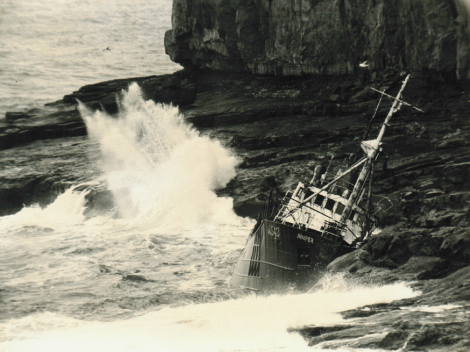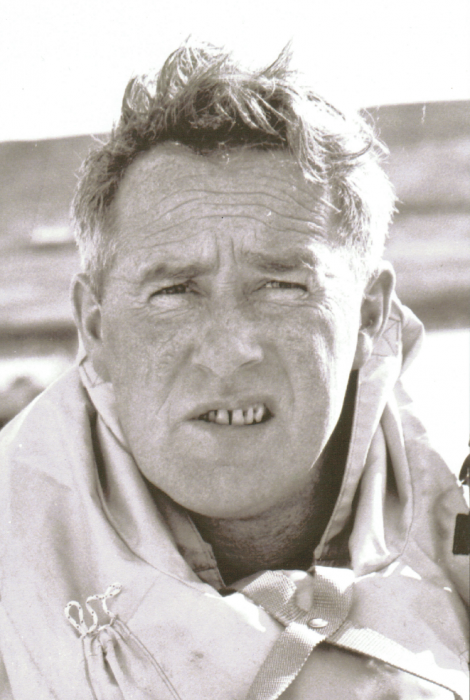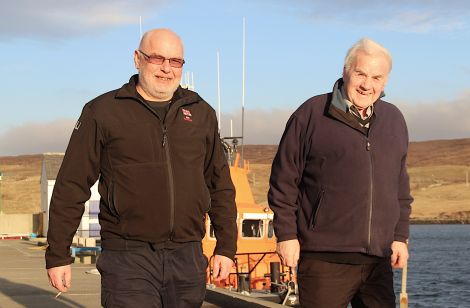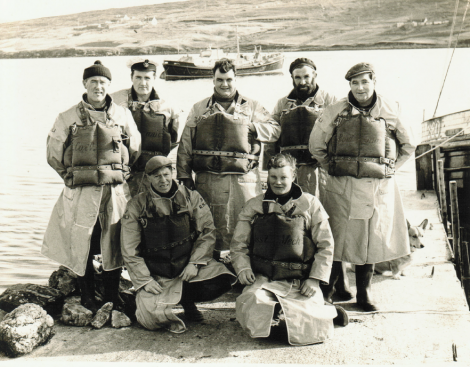Features / Aith remembers ‘superhuman’ effort to rescue 12 fishermen from trawler
AITH lifeboat station is this week remembering the heroic rescue of 12 fishermen from a stricken trawler 50 years ago.
The crew were called out in the early hours of 19 February 1967 and made their way to Papa Stour, where the Aberdeen-registered trawler Juniper had grounded and was jammed against rocks at the foot of sheer cliffs 200 foot high in rough seas and force 7-8 winds.
Coxswain John Robert Nicolson and his crew managed to pull the lifeboat alongside the heaving and rolling vessel and pluck the exhausted Juniper crew from the trawler.
The conditions were so violent that one wave lifted the lifeboat right over the Juniper.
A court report from October that year, which blamed the skipper for the loss of the Juniper, said the lifeboat had to act “in very difficult and dangerous conditions” and was “substantially damaged” during the operation.
The Juniper had been fishing off Eshaness very successfully and, while most of the crew were on board gutting fish, the skipper decided to take the vessel on a course between Papa Stour and Ve Skerries on her way back to Aberdeen.
At 4.30 am the Juniper hit the rocks between Lyra Skerry and Papa Stour at full speed. She became a total loss but all the crew were saved.
Coxswain Nicolson, who died in 2004, was later awarded a silver RNLI bravery medal, the Maud Smith Award for the bravest rescue by a lifeboat during 1967, and the P&O award for bravery.
The rest of the crew – Frank Johnston, Kenny Henry, Jimmy Manson, Wilbert Clark, Jim Tait, Andy Smith and Bill Anderson – received RNLI Thanks of the Institution inscribed on vellum.
Become a member of Shetland News
Recalling the events of February 1967, Johnston, who was the mechanic on board the lifeboat back then, said the sea was already flooding the deck of the Juniper, so they just went in and did what had to be done.
“It was just starting to lighten when we arrived, the Juniper was rocking on a ledge below the cliffs and the sea was rising by about 18 feet, I would say, but then you never think about the weather,” the 74-year-old businessman said.
“The lifeboat crew worked together and that is what makes it – you are together in the same boat.
“They jumped every time we came up and we would try to grab them. There was no time to worry about choices.”
Johnston also recalled how relatively inadequately equipped – compared with today – lifeboats had been 50 years ago.
The John and Francis MacFarlane was equipped with two 72 horsepower engines which gave her a top speed of nine knots, whereas today’s Severn class all-weather Aith lifeboat – the Charles Lidbury – is powered by two 1,250 horsepower engines and has a top speed of 25 knots.
The RNLI’s official report of the rescue says: “The survivors were in poor shape, wet and exhausted, which together with the movement of the boats and the weather made the rescue a most hazardous task.
“However, by a superhuman effort by all the lifeboat crew all 12 men of the trawler crew were hauled aboard the lifeboat without any injuries.
“Once all hands were accounted for, Coxswain Nicolson had to undertake the difficult task of getting the lifeboat back out of the very enclosed area surrounded by high cliffs and with jagged rocks and skerries in various places.”
Current Aith coxswain Hylton Henry, whose father Kenny was also involved in the rescue, added: “It is phenomenal to think what that crew did in that lifeboat in such conditions.”
Become a member of Shetland News
Shetland News is asking its many readers to consider paying for membership to get additional features and services: -
- Remove non-local ads;
- Bookmark posts to read later;
- Exclusive curated weekly newsletter;
- Hide membership messages;
- Comments open for discussion.
If you appreciate what we do and feel strongly about impartial local journalism, then please become a member of Shetland News by either making a single payment, or setting up a monthly, quarterly or yearly subscription.






























































